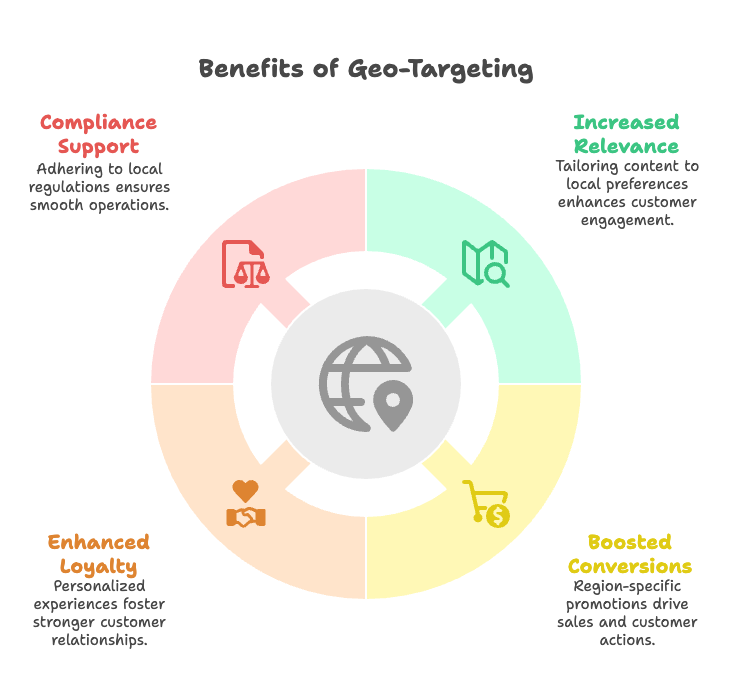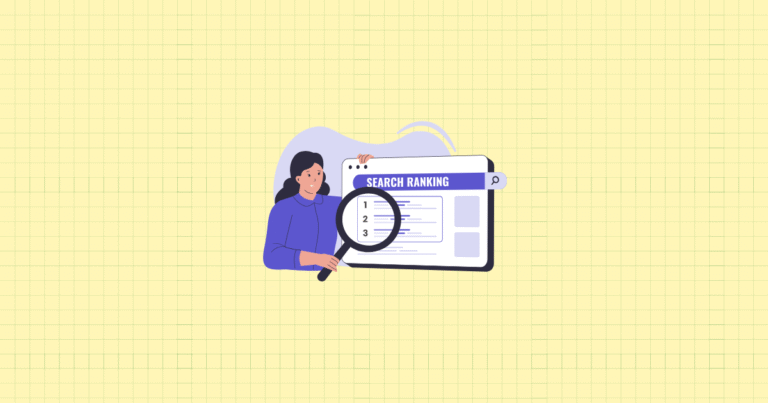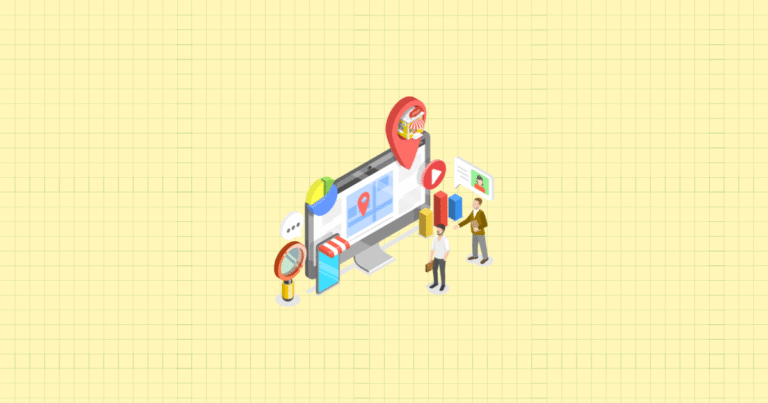Your Shopify store is thriving. Sales are steady, your brand is growing, and you’ve even expanded to multiple locations. But here’s the thing that’s probably keeping you up at night: are you really connecting with customers in each of your markets?
Geo-targeted content isn’t just a fancy marketing buzzword. It’s the difference between sending a generic “Winter Sale” email to customers in Miami and crafting a “Beat the Heat” summer promotion that actually resonates. For multi-location Shopify businesses, this strategy can transform how customers experience your brand.
In this guide, you’ll discover how to leverage Shopify’s built-in features alongside proven tools to create location-specific experiences that boost conversions. We’ll walk through everything from setting up your first geo-targeted campaign to advanced personalization techniques that make customers feel like you truly “get” their local market.
Understanding Geo-Targeted Content for Multi-Location Shopify Stores

Definition and Value of Geo-Targeting
What is Geo-Targeting in E-commerce?
Think of geo-targeting as your digital store’s way of speaking the local language. It’s delivering personalized content, promotions, and products to customers based on their geographic location. Your store uses IP addresses, shipping and billing data, or physical store locations to tailor each visitor’s experience.
But this isn’t just about showing different languages or currencies. Real geo-targeting digs deeper. It increases local relevance, boosts conversions, and enhances customer loyalty by making every interaction feel purposeful and personal.
Why Geo-Targeted Content Matters for Shopify Stores
Every market has its quirks. What works in New York might fall flat in Nashville. Geo-targeted content addresses the unique needs of diverse local markets, from language and cultural preferences to seasonal shopping patterns.
More importantly, it enables region-specific promotions and communications that actually drive people to your physical stores. When someone in Chicago sees “Free pickup at our Lincoln Park location,” that’s not just convenient—it’s conversion gold.
Plus, there’s the practical side. Geo-targeting supports compliance with local regulations and tax requirements, which becomes crucial as you expand into new territories.
Shopify’s Multi-Location Capabilities Overview
Multi-Location Inventory Management
Shopify’s multi-location features are surprisingly robust. You get centralized inventory tracking across warehouses, retail locations, and distribution centers. The system optimizes fulfillment by assigning orders based on the closest available stock, which reduces delivery times and shipping costs.
The real beauty lies in the streamlined processes for local pickup and region-based stock allocation. Customers can see exactly what’s available at their preferred location before they even place an order.
Location-Centric Store Management
Setting up multiple locations in Shopify admin is straightforward. You can set unique pricing, availability, and promotions per location. The platform also integrates seamlessly with POS systems, creating unified online and offline operations that actually talk to each other.
Segmenting and Understanding Your Audience by Geography

Geographic Segmentation Fundamentals
Segmenting Customers in Shopify
Shopify’s built-in segmentation tools let you filter customers by proximity, order history, and shopping preferences. But the magic happens when you pair location data with behavior patterns. Someone who abandons their cart in Miami might respond differently to follow-up emails than someone doing the same in Minneapolis.
You can filter by cities, regions, zip codes, or even draw custom radii around your physical stores. This granular approach helps you identify micro-markets within larger metropolitan areas.
Audience Personas per Region
Each region develops its own personality over time. Urban customers might prioritize convenience and same-day delivery. Rural customers often value detailed product information and reliable shipping timelines. Tourist-heavy areas might see higher impulse purchases but lower repeat customer rates.
Use your analytics to spot high-potential or under-served areas. Sometimes the smallest markets become your most profitable once you give them the attention they deserve.
Data Collection and Management
Leveraging Shopify’s Unified Customer Profiles
One of Shopify’s strongest features is how it integrates POS data, loyalty programs, and online activity into single customer views. The platform captures shipping, billing, and store visit locations automatically. You can use customer tags and Flow automations for granular segmentation without getting lost in spreadsheets.
Privacy and Compliance Considerations
Here’s where things get serious. You must ensure compliance with GDPR, CCPA, and local data protection laws in every market you serve. Communicate transparent data-usage policies, and obtain proper consent for location-based promotions when required.
This isn’t just legal protection—it’s brand protection. Customers trust businesses that handle their data responsibly.
Delivering Personalized, Location-Based Content on Shopify
Localized Storefronts and Dynamic Content
Shopify Localization Tools
Shopify Markets and the Translate & Adapt app work together to create multi-language and multi-currency experiences. But it’s not just about translation. You can show correct pricing, legal disclaimers, and offers for each country or region automatically.
For developers, Liquid code like request.country or request.market lets you display tailored messaging dynamically. Non-developers can achieve similar results using apps and theme customizations.
Custom Content for Different Locations
This is where creativity meets strategy. Promote local events, region-specific collections, or seasonal items on relevant pages. Use banners, pop-ups, or dedicated landing pages for city or state-targeted campaigns.
Always highlight nearby store locations and real-time inventory availability. When customers can see “3 items available at Downtown Seattle location,” it creates urgency and confidence simultaneously.
Geo-Targeted Promotions and Discounts
Running Location-Specific Promotions
Exclusive deals for specific locations feel special. “Welcome Austin Shoppers! 10% Off Local Pickup” works because it’s personal and practical. Schedule discounts around local holidays, grand openings, or store anniversaries.
Shopify Flow or specialized apps can automate promotional logic based on customer location. Set it up once, and let the system handle the targeting while you focus on creating great offers.
Implementing Geofencing and Retargeting
Combine geofenced ads on Meta and Google with Shopify Audiences to boost regional sales. Retarget lapsed local customers with tailored email, SMS, or social campaigns that reference their specific area.
Always measure promotional effectiveness using Shopify Analytics. What works in one market might need adjustments in another, and data helps you optimize continuously.
Essential Geo-Targeting Tools and Apps for Shopify
Native Features and Shopify Markets
Leveraging Built-in Shopify Tools
Start with what Shopify gives you for free. Shopify Markets handles localization, currencies, and product availability across regions. Location Management in your admin controls inventory, pickup options, delivery zones, and regional order allocation.
The Translate & Adapt app provides seamless language support and region-localized content. These native tools often provide 80% of what most businesses need before considering third-party solutions.
Setting up and Managing Multiple Locations
Adding store locations in Shopify admin is straightforward. Navigate to Settings > Locations, add your addresses, and assign inventory accordingly. Configure unique shipping zones, tax rates, and product availability per location.
The key is integrating inventory management with analytics for ongoing optimization. Monitor which locations generate the most online orders, which products move fastest at each site, and where you might need additional stock.
Advanced Geo-Targeting Apps
Top Geolocation Apps for Shopify
When native features aren’t enough, several apps excel at geo-targeting. Orbe offers customizable geolocation popups, store version recommendations, and visitor preference storage. Geo:Pro provides automatic redirects, location-based product matching, and user-friendly controls.
Geo-Target IP Banner creates dynamic content sections by country or IP address, perfect for targeted messaging and announcements. Each app has strengths depending on your specific needs and technical comfort level.
Integrating and Customizing App Features
Set clear geolocation rules for redirects, product visibility, languages, and currencies. Customize popups and banners to match your brand design for each region—consistency matters even when content varies.
Combine app analytics with Shopify data for comprehensive insights. The goal is seamless integration that enhances rather than complicates the customer experience.
Analytics, Optimization, and Best Practices
Measuring Geo-Targeted Content Performance
Key Metrics and KPIs
Track conversion rates, bounce rates, and average order values by region. But don’t stop there. Monitor how location-based campaigns affect customer engagement and lifetime value across different markets.
Shopify Analytics and custom dashboard reports help aggregate insights, but the real value comes from comparing performance across regions. Why does Phoenix convert better than Phoenix suburbs? What can you learn from your top-performing locations?
Iterative Testing and Improvement
Run multivariate tests on regional content, offers, and user experience changes. Gather customer feedback locally through reviews, survey responses, and returns data. This qualitative information often reveals insights that numbers alone miss.
Adjust strategies based on both analytical findings and emerging trends. Seasonal patterns, local events, and economic changes all influence how your geo-targeted content performs.
Advanced Strategies and Common Pitfalls
Advanced Personalization Techniques
Use regional preferences to drive product recommendations and dynamic merchandising. Leverage cultural holidays, language nuances, and local influencer partnerships to create authentic brand resonance.
Don’t forget local SEO. Optimize your store locator, maintain Google My Business profiles, and ensure your geo-targeted content supports omnichannel discovery and engagement.
Pitfalls to Avoid
Over-segmentation creates operational complexity without proportional benefits. Balance personalization with manageability—you want strategies you can actually execute consistently.
Maintain consistent branding and core messaging across locations while allowing for local customization. Your brand identity should remain recognizable whether someone shops in Seattle or Miami.
Never neglect compliance, language accuracy, or user privacy in targeted content. These fundamentals protect both your customers and your business reputation.
Implementation Roadmap & Next Steps
Step-by-Step Shopify Implementation Checklist
Start by auditing and mapping your key markets and locations for targeted content. This foundation determines everything that follows.
- Enable Shopify Markets and multiple locations in your admin – Set up the technical infrastructure first
- Segment your customer base geographically – Use Shopify’s built-in tools to identify patterns and opportunities
- Set up localization – Configure languages, currencies, and location-specific content
- Schedule region-specific promotions – Plan campaigns that align with local events and preferences
- Integrate and configure geolocation apps – Add advanced functionality as needed
- Launch, monitor, and optimize – Use analytics data to continuously improve your strategies
Future-Proofing Your Geo-Targeted Content Approach
Stay updated on Shopify’s evolving localization and multi-location features. The platform regularly adds new capabilities that could enhance your geo-targeting efforts.
Regularly update content and offers in collaboration with local market teams or partners. Fresh, relevant content maintains engagement and search visibility.
Test emerging tools and beta features that enable deeper personalization. Early adoption often provides competitive advantages before these capabilities become standard.
Most importantly, foster a feedback loop with local customers for agile improvements. Your customers are your best source of insight into what’s working and what needs adjustment in each market.
References
- Shopify. “What is Geotargeting in Retail? Examples & Use Cases.” Shopify, 7 May 2025. https://www.shopify.com/retail/geotargeting-retail
- Shopify. “Geographic Segmentation: How To Build a Strategy (2025).” Shopify Blog, 4 June 2025. https://www.shopify.com/blog/geographic-segmentation
- Marketinglib. “Location-Based Loyalty: Geo-Targeted Discount Strategies for Shopify.” Marketinglib, 2025. https://marketinglib.com/location-based-loyalty-geo-targeted-discount-strategies-for-shopify/
- UltraLabs Digital. “How to Use Geo-Targeting for Shopify Stores.” UltraLabs, 23 March 2025. https://ultralabs.digital/blogs/ecom-insights/how-to-use-geo-targeting-for-shopify-stores
Ready to transform your multi-location Shopify business with intelligent geo-targeting that actually converts? Growth Suite helps you deliver perfectly timed, location-specific discount offers that boost sales while protecting your brand integrity. Our smart targeting ensures promotions reach the right customers at the right moment, maximizing your conversion rates across all locations. Install Growth Suite with a single click and start optimizing your geo-targeted campaigns today—it’s completely free to get started!




